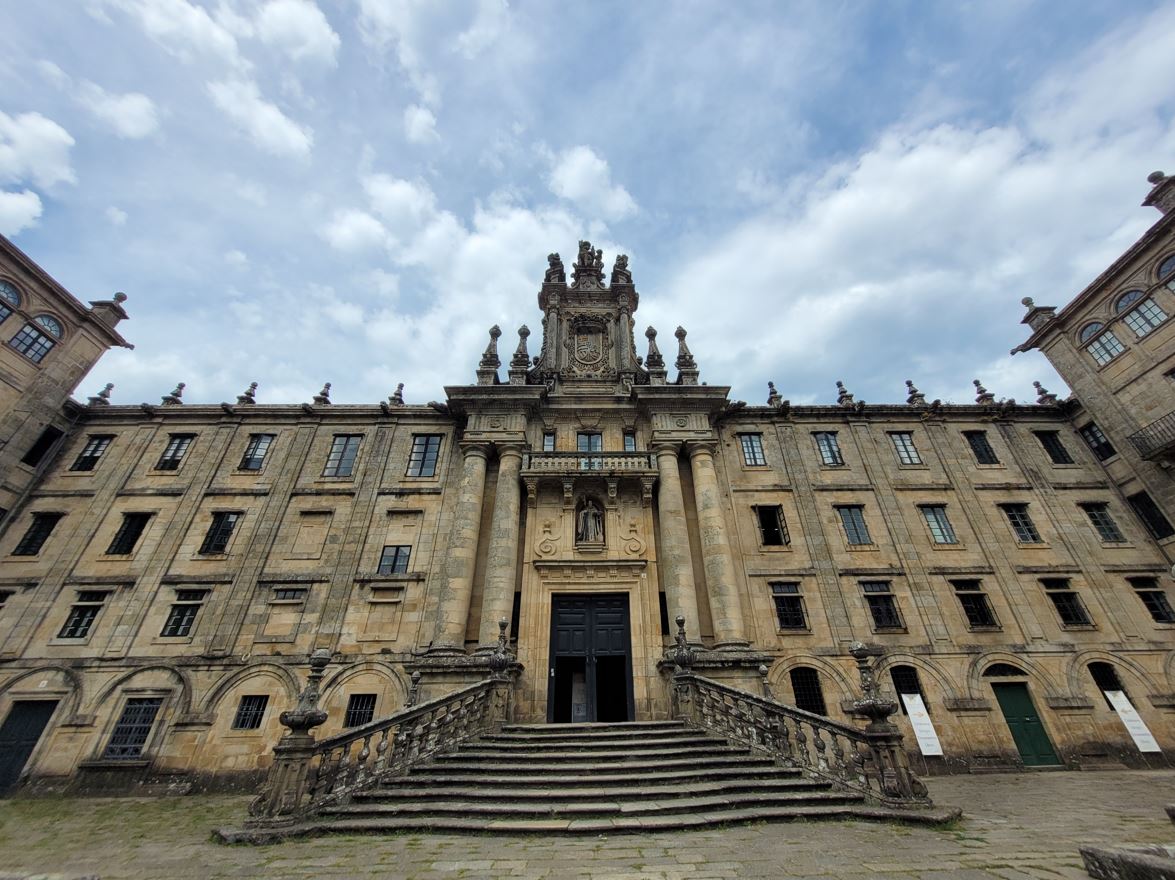Au nord de la cathédrale de Saint-Jacques-de-Compostelle se trouve le monastère San Martino Pinario, le deuxième plus grand monument religieux de la ville après la cathédrale, et le deuxième plus grand monastère d’Espagne, après San Lorenzo de El Escorial, avec une surface de 20 000 mètres carrés, sa façade principale étant de 100 mètres de long.
San Martino Pinario a été fondé à l’emplacement d’une ancienne chapelle dédiée à la Sainte Vierge, « La Corticela ». Mais cette chapelle est détruite au IXe siècle (un vestige en est toujours visible dans la cathédrale), et un monastère bénédictin lui succède, dont l’église est consacrée en 1102 par l’évêque Diego Gelmirez. Le nom de « Pinario » s’explique par les pins qui se trouvaient à cet endroit au moment de la fondation du monastère. Il s’agrandit au cours des siècles, connaît son apogée au XVe en passant sous le contrôle de la congrégation de Valladolid en 1494 et grâce à la fondation de l’Hôpital Royal en 1499 par les rois catholiques.
Les richesses acquises par le monastère permettent sa reconstruction à la fin du XVIe et au XVIIe siècle : c’est l’édifice que nous connaissons actuellement. Sa façade est de style baroque, comme la majeure partie du monument. Elle est couronnée d’une statue figurant la Charité de saint Martin. L’édifice reste un monastère bénédictin jusqu’aux confiscations ecclésiales de Mendizábal (expropriations des monastères en Espagne entre 1835 et 1837). Il est rendu à l’archidiocèse de Saint-Jacques-de-Compostelle en 1868.
Aujourd’hui, l’édifice abrite le Grand Séminaire, les archives diocésaines et l’Institut théologique de Compostelle d’une part, l’école universitaire du travail social, dépendant de l’Université de Compostelle, d’autre part. Le reste de l’ancien monastère est l’Hospedaria San Martino Pinario, un hôtel de 81 chambres qui a gardé sa facture XVIe siècle malgré tout le confort moderne. Seule l’église, aujourd’hui musée, est visitable.
North of the Cathedral of Santiago de Compostela is the San Martino Pinario Monastery, the second largest religious monument in the city after the cathedral, and the second largest monastery in Spain, after San Lorenzo de El Escorial , with an area of 20,000 square meters, its main facade being 100 meters long.
San Martino Pinario was founded on the site of an old chapel dedicated to the Blessed Virgin, « La Corticela ». But this chapel was destroyed in the 9th century (a vestige of it is still visible in the cathedral), and a Benedictine monastery succeeded it, whose church was consecrated in 1102 by Bishop Diego Gelmirez. The name « Pinario » is explained by the pines that were in this place when the monastery was founded. It grew over the centuries, reaching its peak in the 15th century when it came under the control of the congregation of Valladolid in 1494 and thanks to the foundation of the Royal Hospital in 1499 by the Catholic kings.
The wealth acquired by the monastery allowed its reconstruction at the end of the 16th and 17th centuries: this is the building we know today. Its facade is in the Baroque style, like most of the monument. It is crowned with a statue depicting the Charity of Saint Martin. The building remained a Benedictine monastery until the ecclesial confiscations of Mendizábal (expropriations of monasteries in Spain between 1835 and 1837). It returned to the Archdiocese of Santiago de Compostela in 1868.
Today, the building houses the Major Seminary, the diocesan archives and the Theological Institute of Compostela on the one hand, the university school of social work, dependent on the University of Compostela, on the other. The remains of the former monastery is the Hospedaria San Martino Pinario, an 81-room hotel that has kept its 16th-century feel despite all the modern conveniences. Only the church, now a museum, can be visited.

 "/>
"/>